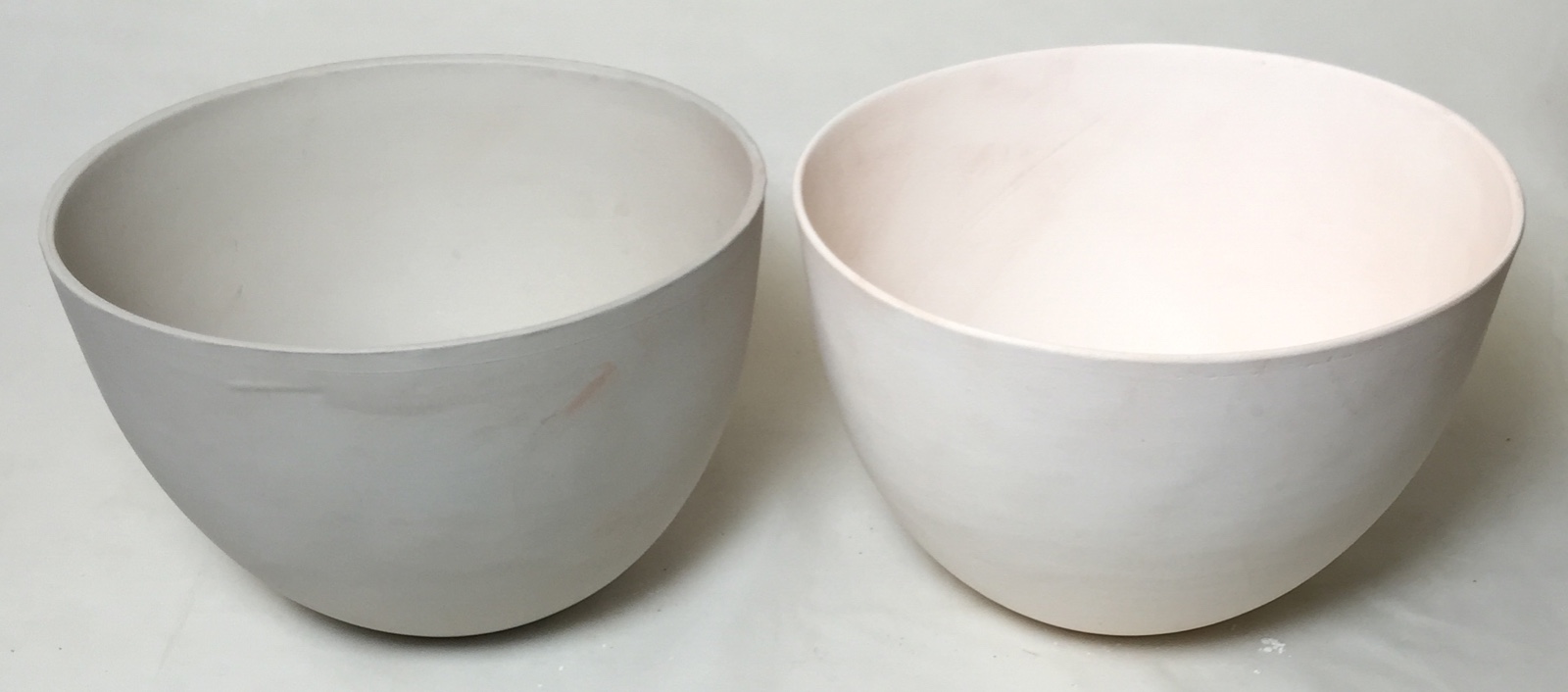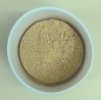| Monthly Tech-Tip | No tracking! No ads! | |
Sintering
A densification process occurring within a ceramic kiln. With increasing temperatures particles pack tighter and tighter together, bonding more and more into a stronger and stronger matrix.
Key phrases linking here: sintering, sintered, sinters, sinter - Learn more
Details
The term "sintered" refers to the particle-to-particle bonding and packing that occurs, in the absence of particle melting, within a ceramic matrix as temperature increases. Sintering is a process as well as a state. Sintered bodies are not vitrified; the process occurs without any glass development to glue particles together. When a sufficient temperature is reached, adjacent particles bond or fuse together at points of contact by the migration of molecular species across the boundaries. This molecular exchange accelerates with increasing temperature as surfaces become more and more chemically active. In addition, increasing temperature makes particle surfaces more slippery, they are freer to rearrange in an ever-increasing density. Finer particle sizes and judicious distributions of sizes, likewise can increase surface area and thus points of contact, that increases fired strength even further.
The sintering process begins in a clay when it has been fired high enough so that it no longer will slake or break down when exposed to water, that can achieved as low as red heat (e.g. 1100F). Bisque fired ware (e.g. 1800F) has advanced to a higher state of sintering. Refractories can often be sintered to considerable strength because the high temperatures maximize particle packing and surface interaction. Sintered alumina or zircon bodies, although not vitrified, can even have a 'ring' like that of a fine porcelain. Some sintered bodies achieve even greater particle bonding by the deposition and buildup of material that has become gaseous in the kiln atmosphere. And interesting advantage of sintering over vitrification is that the hot strength of a body at temperature T will be greater if it is first fired at a temperature higher than T. If it is fired again even hotter (assuming of course that no melting is occurring), it will have even more strength at temperature T.
The sintering process is a natural for new one-step 3D printing technologies that employ high-intensity lasers to rapidly fire extruded pastes as they are being printed.
Related Information
How much does the size of a piece change when it is bisque fired? Glaze fired?

This picture has its own page with more detail, click here to see it.
Three mugs. Dry. Bisque fired. Glaze fired. Notice the shrinkage at each stage (these were the same size in the dry state).
National Standard Bentonite fired to 1650F in a crucible

This picture has its own page with more detail, click here to see it.
The powder was simply put into this cast crucible and fired. Sintering is just beginning.
Non-vitreous bodies break very differently than vitreous ones

This picture has its own page with more detail, click here to see it.
The particles in low temperature bodies are not glass-bonded, they only have sinter bonds. Broken edges will only be sharp if there is a glaze. They tend to break off in pieces rather than shatter.
The difference between vitrified and sintered

This picture has its own page with more detail, click here to see it.
The top fired bar is a translucent porcelain (made from kaolin, silica and feldspar). It has zero porosity and is very hard and strong at room temperature (because fibrous mullite crystals have developed around the quartz and kaolinite grains and feldspar silicate glass has flowed within to cement the matrix together securely). That is what vitrified means. But it has a high fired shrinkage, poor thermal shock resistance and little stability at above red-heat temperatures. The bar below is zirconium silicate plus 3% binder (VeeGum), all that cements zircon ceramics together is sinter-bonds between closely packed particles (there is some glass development from the Veegum here). Yet it is surprisingly strong, it cannot be scratched with metal. It has low fired shrinkage, low thermal expansion and maintains its strength and hardness at very high temperatures.
Can you make things from zircopax? Yes.

This picture has its own page with more detail, click here to see it.
Only 3% Veegum will plasticize Zircopax (zirconium silicate) enough that you can form anything you want. It is even more responsive to plasticizers than calcined alumina is and it dries very dense and shrinkage is quite low. Zircon is very refractory (has a very high melting temperature) and has low thermal expansion, so it is useful for making many things (the low thermal expansion however does not necessarily mean it can withstand thermal shock well). Of course you will have to have a kiln capable of much higher temperatures than are typical for pottery or porcelain to sinter it well.
My first zircopax kiln shelf

This picture has its own page with more detail, click here to see it.
It is 5 mm thick (compared to the 17mm of the cordierite one). It weighs 650 grams (vs. 1700 grams). It will perform at any temperature that my test kiln can do, and far in excess of that. It is made from a body I slurry up (80% Zircopax Plus, 16.5% 60-80 Molochite grog, 3.5% Veegum T). The body is plastic and easy to roll and had 4.2% drying shrinkage at 15.3% water. The shelf warped slightly during drying (I should have dried it between sheets of plasterboard). Firing at cone 4 yielded a shrinkage of 1%. Notice that cone on the shelf: It has not stuck even though no kiln wash was used! Zircopax is super refractory! This is sinter bonded, so the higher the temperature you can fire the stronger it will be. Although it would be very hard to make full 18 or 22-inch shelves for larger kilns, smaller ones designed to "network" would enable a tighter load of ware with a much lower shelf-to-ware weight ratio (especially using my own lightweight posts). Like alumina, this does not have the thermal shock resistance of cordierite, uneven heating can crack these.
Bisque temperature can be lower than you think

This picture has its own page with more detail, click here to see it.
These bowls are made from a talc:ball clay mix, they are used for calcining Alberta and Ravenscrag Slips (each holds about one pound of powder). The one on the right was bisque fired to cone 04 (about 1950F). The one on the left was fired to only 1000F (540C, barely red heat), yet it is sintered and is impervious to water (strong enough to use for our calcining operations). That means that there is potential, in many production situations, to bisque a lot lower (and save energy). Primitive cultures made all their ware a very low temperatures. Tin foil melts at 660C (1220F) yet can be used on campfires for cooking (so the temperatures of primitive wares would have been low indeed).
The silica pants of this cone 10R mug have fallen down!

This picture has its own page with more detail, click here to see it.
This stoneware mug was glazed inside and halfway down the outside with pure silica. At some point during heatup the outside layer, not shrinking like the piece, simply fell down. And was sintered enough to hang together and remain intact through the rest of the firing (on the inside, the shrinking forced the silica to flake off into a pile at the bottom). Cone 10 has sintered the silica enough that it will not slake in water but it is fragile and soft and must be handled carefully.
Cross section comparison between cone 04 terra cotta and cone 6 iron stoneware

This picture has its own page with more detail, click here to see it.
Both of these bodies have a range of particle sizes (from 42 mesh and finer). The glaze on the cone 04 section (close-up on the left) is very well melted, but its interfacial zone with the body is narrow, it is basically just "stuck on" the surface (so it must be tuned to match the thermal expansion of the body to prevent crazing/shivering). The body is not developing any clearly visible glassy phases, meaning that any strength it has is purely a product of sintering. On the right, the interfacial zone of glaze-with-stoneware-body is wider. The body has incipient melting (tiny feldspar particles are fusing and beginning to dissolve into the surfaces of surrounding ones). The color has changed from red to brown.
Inbound Photo Links
 What is sintering? |
Links
| Temperatures | Sintering and densification (850-) |
| URLs |
http://en.m.wikipedia.org/wiki/Sintering
Sintering on Wikipedia |
| Articles |
Formulating a Porcelain
The principles behind formulating a porcelain are quite simple. You just need to know the purpose of each material, a starting recipe and a testing regimen. |
| Glossary |
Ceramic
Ceramic materials are among the hardest and most heat resistant materials known. Ceramics spans the spectrum from ancient terra cotta to modern hi-tech materials. |
| Glossary |
Ceramic Stain
Ceramic stains are manufactured powders. They are used as an alternative to employing metal oxide powders and have many advantages. |
| Glossary |
Refractory
In the ceramic industry, refractory materials are those that can withstand a high temperature without deforming or melting. Refractories are used to build and furnish kilns. |
| Glossary |
Abrasion Ceramics
Man-made ceramic surfaces are among the most abrasion resistant materials known. Products made to abrade others are also made from bonded ceramic grains. |
| Glossary |
Fired Strength
Ceramics, by their brittle nature, have high compressive strength. But in functional ceramics we are more concerned about the tensile strength as this relates better to serviceability. |
| Glossary |
Primitive Firing
The use of some traditional firing techniques is still popular among modern potters and sculptors (who are accustomed electric and gas kilns, often with computer controllers). |
| Glossary |
Vitreous
The fired state of a ceramic when sufficient heat in the kiln has produced the density and strength common, and expected, in stonewares and porcelains. |
| Oxides | Al2O3 - Aluminum Oxide, Alumina |
| By Tony Hansen Follow me on        |  |
Got a Question?
Buy me a coffee and we can talk

https://digitalfire.com, All Rights Reserved
Privacy Policy
